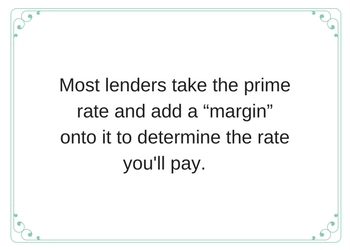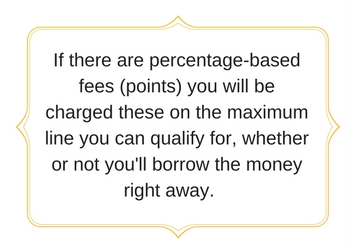 This article provides an overview of factors influencing the price of a home equity loan or home equity line of credit (HELOC).
This article provides an overview of factors influencing the price of a home equity loan or home equity line of credit (HELOC).
Home equity loans -- often with fixed rates - can be viewed as the old "second mortgage" with a new name. Some of these can be sold to "secondary mortgage markets"; essentially, other companies that pool the loans and turn them into bond offerings. Where this is the case, the lender isn't planning on holding the loan in its portfolio, and because the lender doesn't have to manage any interest rate, prepayment or default risks, it may be able to offer a low interest rate.
Home equity lines of credit are termed "adjustable" or "variable;" that is, their interest rates can move upward or downward with changes in other interest rates. The interest rate charged is pegged to one of these indexes, which is an economic indicator. Far and away, the most common index used on home equity lines of credit is the prime rate as published in the Wall Street Journal; the prime rate is normally the base rate for a lender's best business customers. This rate is determined by the nation's big "money center" banks, and normally changes in response to economic conditions -- like changes in the federal funds rate by the Federal Reserve.
Before you add any options or features to your line or loan, a lender looks at several factors to determine what your base interest rate will be, which falls at the intersection of several important factors. These include your credit score, your debt-to-income (DTI) ratio, the amount of leverage against the home you need (combined loan-to-value ratio, or CLTV) and, of course, the dollar amount you wish to borrow.
 How home equity loan and HELOC rates are determined
How home equity loan and HELOC rates are determined
Most lenders take the prime rate and add a "margin" onto it to determine the rate you'll pay. A margin is the markup that the lender adds to the index to arrive at your interest rate. The average margin added to the prime rate is about 0.75%, although they may range from -1% to 5%. Some lenders price by the line's dollar amount, others, by CLTV ratio (and some use both). This is called 'tier' pricing. Often, lines with small loan amounts or those with higher CLTVs carry larger margins.
In most areas of the country, you can borrow at the prime rate with no margin. In some markets, you can borrow with a rate that is below prime for the line's life. However, the lowest rates may come with closing or loan fees and even points. If there are percentage-based fees (points) you will be charged these on the maximum line you can qualify for, whether or not you'll borrow the money right away. If a lender was to charge you 1.5 points to borrow at the prime rate, and you borrowed a $10,000 line, as in our previous example, you would be charged about $150 to get that lower interest rate. Paying points or fees might make sense, though, and we'll discuss this in our next article on "fees."
 Increasingly, lenders offer discounts on your rate or margin of up to a half-percentage point if you agree to open a checking account at their institution and agree to have your payments automatically-debited from that account each month or other such requirements (such as direct deposit of your paycheck). Not everyone needs another checking account or likes auto-payments, discounts or not, and it's important to weigh whether or not such offers have any value to you.
Increasingly, lenders offer discounts on your rate or margin of up to a half-percentage point if you agree to open a checking account at their institution and agree to have your payments automatically-debited from that account each month or other such requirements (such as direct deposit of your paycheck). Not everyone needs another checking account or likes auto-payments, discounts or not, and it's important to weigh whether or not such offers have any value to you.
Other indexes common to some markets include Treasury bills or securities, or a relatively new index called Secured Overnight Financing Rate (SOFR), which is replacing LIBOR, an index that was formally discontinued in 2023. Any existing HELOCs that were tied to LIBOR may be migrated to a new, contrived index called "Refinitiv USD IBOR Consumer Cash Fallback Index", which is based on SOFR and is a "spread-adjusted, SOFR-based replacement index".
Common home equity line pricing
|
Index |
Calculation |
Interest rate |
|
Prime rate (7.50%) |
plus typical margin of 2.00% equals |
9.50% |
|
Treasury bills & securities (5.24%) |
plus typical margin of 3.50% equals |
8.74% |
|
90-day SOFR (5.0144%) |
plus typical margin of 3.50% equals |
8.50144% |
Keep in mind that Treasury bills can change very quickly; a good rate today does not guarantee a good rate tomorrow. The prime rate tends to follow what happens with the federal funds rate, and so may move infrequently at times and rapidly at others, and often in quarter of half-point blocks. SOFR typically uses a value that looks back over the previous 90 days, and so lags changes in other interest rates a bit. Slow moving indexes can help insulate you from quick rate increases.
Regardless of the index, most lenders recalculate your interest rate on a monthly basis; others do it less frequently. Some lenders, however, don't use the current prime rate, and may use the average for the month, or quarter. Ask your lender when and how your rate will be recalculated. Lenders that use Treasury bills and securities most often adjust with the maturity of the security or bill, typically one, three or six months.
In addition to interest, home equity borrowers may also have to pay fees and there can be tax implications of having a home equity loan or line. The next article in HSH.com's home equity guide reviews these costs.
Next article: Home equity borrowing fees
Previous article: Special home equity borrowing terms



